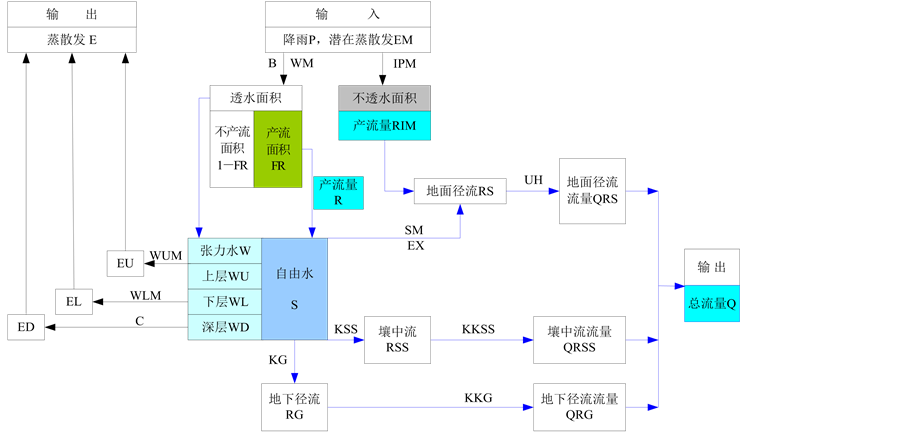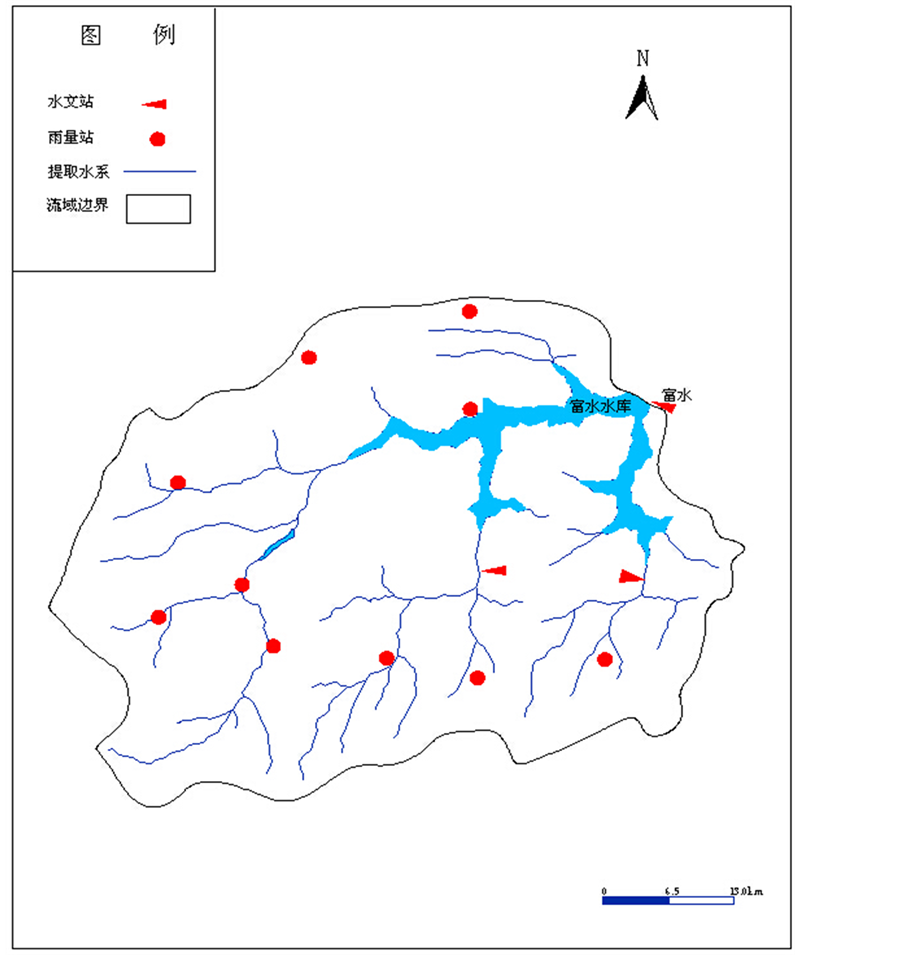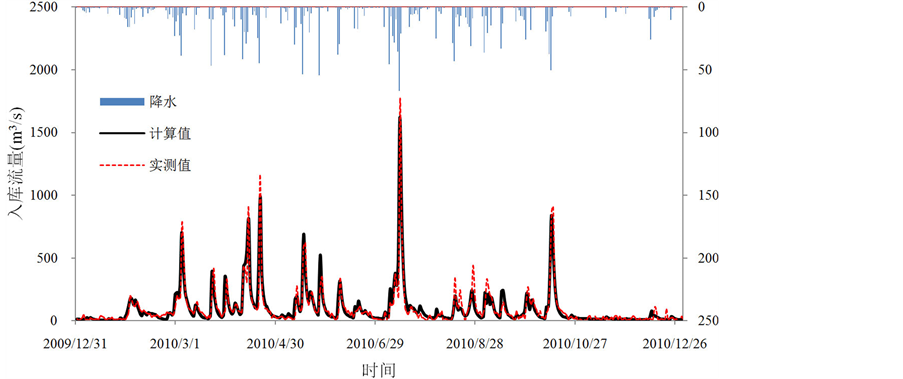1. 引言
富水水库位于湖北省阳新县境内,长江水系富水流域富水河上,控制流域面积2450 km2,总库容16.65 m3,是一座以防洪、发电为主综合利用的大(I)型水库。水库设计洪水标准为千年一遇洪水设计,万年一遇洪水校核。富水为长江中下游南岸一级支流,发源于湖北省的通山、崇阳和江西省修水三县交界处的幕阜山北麓,向东流经通山、阳新两县,沿途顺次纳入南北支流横石河、黄沙黄、燕厦河、龙港河和三溪河等主要支流及湖泊来水,至富池口汇入长江。本文采用三水源新安江模型对富水水库入库洪水预报进行研究。
2. 研究方法
2.1. 新安江模型
新安江模型是河海大学赵人俊教授等提出来的概念性水文模型 [1] ,经不断改进与发展,已成为国内外应用广泛的流域水文模型之一,尤其适应于南方湿润地区。本研究采用划分径流为地表径流、壤中流以及地下径流的三水源新安江模型。采用蓄满产流假定进行产流计算,将流域内各点不同土壤含水容量概化成蓄水容量曲线。蒸散发计算采用三层蒸发模式计算,将土壤层划分为上层、下层以及深层。三水源新安江模型将净雨划分成地面径流、壤中流以及地下径流,其中地面径流采用单位线进行汇流计算,壤中流和地下径流经过线性水库的调蓄分别作为地下水出流和壤中流出流 [2] 。其计算流程见图1。
2.2. 评价方法
采用2个指标评价模型精度:径流总量相对误差RE、确定性系数DC,计算公式分别如下:
(1) 径流总量相对误差
 (1)
(1)
(2) 确定性系数
 (2)
(2)
式中: 为模拟流量值;
为模拟流量值; 、
、 分别为实测流量值及其均值;n为资料序列长度。
分别为实测流量值及其均值;n为资料序列长度。
3. 实例应用
3.1. 富水水库概况及基本资料
富水为长江中下游南岸一级支流,发源于湖北省的通山、崇阳和江西省修水三县交界处的幕阜山北麓,向东流经通山、阳新两县,沿途顺次纳入南北支流横石河、黄沙黄、燕厦河、龙港河和三溪河等主要支流及湖泊来水,至富池口汇入长江。
如图2所示,富水流域面积5310 km2,干流长度194.6 km,平均宽度43 km,境内地势西南高东北低,最高峰为西南部的老鸦尖,海拔1657 m,最低处为下游湖区约12~15 m;干流通山以上为上游,河道陡峻;通山至阳新为中游,低山、丘陵互见;阳新至富池池口为下游,地势平坦,湖泊众多,富水河道总落差613 m。富水流域属亚热带季风气候,其下游平均气温16.6℃,年最高气温41.4℃ (1966年8月10日),年最低气温−14.9℃(1969年2月1日)。流域多年平均降水量1594 mm,降雨年内分配不均,4~8月占全年降水量的三分之二,流域多年平均径流量22.1亿m3。根据流域的自然地理及气候特征,选用新安江模型是合适的。
选用2000~2014年共计15年日资料和37场洪水资料进行模型计算,其中2000~2009年作为率定期,2010~2014年作为检验期。资料包括13个雨量站的逐日和4段制降雨资料,富水水库反演的逐日和时段入库流量过程,富水水位站(出库站) E601蒸发皿逐日蒸发资料,水库有关特征曲线资料等。流域面雨量采用泰森多边形法计算,流域平均蒸发量采用富水站实测蒸发数据[3] 。
3.2. 结果分析
先根据模型参数概念分析方法初定参数范围和初值,然后根据合适的目标函数进行参数率定[4] -[6] 。日模型和次模型的参数率定结果见表1。
从表2富水水库新安江日模型模拟结果可以看出,日模模拟中年产流量绝对误差小于100 mm的有15次,占100%,绝对误差小于20 mm的有6次,占40%,产流量相对误差均小于5%。确定系数最小为0.72,最大为0.96,率定期均值为0.89,检验期均值为0.88。

Figure 1. Flowchart of three-water sources Xin’anjiang model
图1. 三水源新安江模型流程图

Figure 2. Distribution of gauged stations in Fushui basin
图2. 富水流域水系及站点分布
从表3富水水库新安江次洪模型模拟结果可以看出,次洪模拟中,次洪产流量绝对误差小于5 mm的有29次,占78%,绝对误差最大为10.6 mm。产流量相对误差小于10%的有30次,占81%。确定系数最小为0.81,最大为0.97,率定期和检验期的均值都为0.90。图3和图4分别展示了新安江日模和次模在检验期的模拟入库流量和反推入库流量过程。
4. 结语
本研究采用新安江模型对富水水库入库流量进行了日模和次洪过程模拟,参数率定以确定性系数为目标函数,通过对模拟结果进行分析,得到如下结论及展望:
(1) 采用新安江模型对水库入库流量进行预报研究,模型结果精度较高,可作为富水入库洪水预报方案。

Table 1. Calibrated parameters of the Xin’anjiang model in Fushui basin
表1. 富水水库新安江模型参数率定结果

Table 2. Daily results of the Xin’anjiang model in Fushui basin
表2. 富水水库新安江日模型模拟结果

Table 3. Hourly results of the Xin’anjiang model in Fushui basin
表3. 富水水库新安江次洪模型模拟结果

Figure 3. Comparison of simulated and observed daily reservoir inflow of 2010 in the validation period
图3. 检验期2010年日模拟与观测结果比较图

Figure 4. Comparison of simulated and observed hourly reservoir inflow of 2010 in the validation period
图4. 检验期2011年小时模拟与观测结果比较图
(2) 逐日和时段流量过程均通过水库水量平衡反推得出,由于水位观测的误差,以及采用的出库流量的误差,会对模拟结果的确定性系数造成影响。另外,水库蓄泄的不确定性,对计算与实测结果有一定的影响。